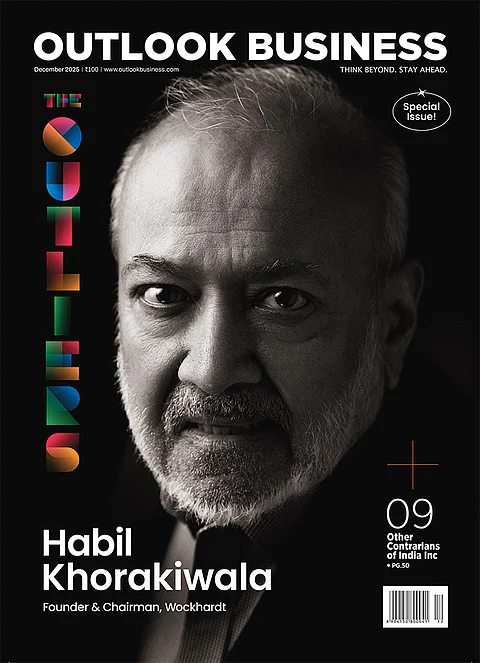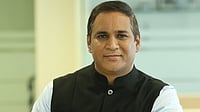
PhysicsWallah to debut on Dalal Street after major expansion in offline centres and exam categories
Alakh Pandey says IPO marks shift from heavy investment to sustainable growth phase
Firm’s cash flow from operations rose from ₹212 crore in FY24 to ₹506 crore in FY25
“It’s good to be in the public eye as past examples in the edtech sector have not been great,” PhysicsWallah founder and CEO Alakh Pandey told Outlook Business in an exclusive interview ahead of the IPO (initial public offering).
The edtech platform is slated to open its IPO on November 11, seeking to raise ₹3,480 crore via a ₹3,100 crore fresh issue and a ₹380 crore offer-for-sale led by promoters. The price band is set at ₹103-109 per share, with 75% of the issue reserved for qualified institutional buyers, 15% for retail investors and 10% for non-institutional investors.
The RHP positions the listing as a growth capital raise tied to accelerated offline and online expansion. While Pandey says that the major investor phase is over, the cofounders now want the public to be a part of PW’s journey. He insists that this is more than just an IPO, it is a declaration of disclipline.
The company's maiden public offering will conclude on November 13, and anchor investors will be allocated shares on November 10. Both promoters -- Alakh Pandey and Prateek Boob -- will each offload shares worth ₹ 190 crore through the OFS. At present, both hold 40.31 % stake each in the company.
Edited excerpts:
As you have mentioned that PhysicsWallah wanted to list on Indian bourses whilethe firm is in a growth phase. Can you explain the KPI thresholds or milestones you used to decide that now was the right time to go public?
We have decided about getting listed during our two major investments: first, new categories in online classes and second, offline expansion during FY23 and FY24. We opened centres rapidly and launched new exam categories such as UPSC, ICA, Commerce, and MBA after starting with JEE and NEET. Our major investment was in creating these exam categories. When we launch a new category, students don’t join immediately. We first teach for free on YouTube to build community and distribution. After this, we launch a proper online batch, which may have 5,000 or 10,000 students.
Initially, the cost of teachers, smart boards, infrastructure is fixed. As more students join, it moves toward profitability. Every exam has its own critical number: for some, 4,000 students; for others, 1,000 or 9,000. We launched 34 exams in two years, so major investments went there.
Many of these exams have now become profitable, while some are at breakeven. Even offline, we opened 170 centres in two years. Our expansion run rate is now slower than before, which is about 70 centres going forward. So, we feel that the major investment phase is largely over.
If you look at EBITDA, it has improved dramatically in the last two years. Our control on the bottom line has strengthened. Cash flow from operations also grew i.e., ₹200 crore in FY24 and ₹500 crore in FY25. All these indicators showed sustainable growth. Major investments are done, the offline model and unit economics are figured out.
And this was the time when we decided to go for an IPO. The bottom line is clear and improving. We felt that public investors can now become our partners in this growth journey. Also, I felt that it’s good to be in the public eye because past examples in the edtech sector haven’t been great. Going through the IPO process, the company itself improved significantly. We brought in independent directors, built new processes, and became more disciplined.
I hold a large equity stake, so I’m committed to running it for life. More than equity, it’s my personal brand and identity. So, listing is also an emotional decision. By listing during our growth phase, everyone can benefit and be part of our journey.
The edtech sector in India has been in the spotlight, often for the wrong reasons. With the IPO, governance becomes even more crucial. What changes do you expect in governance after listing?
Honestly, most changes have already happened before listing like major investment decisions, new launches, board members, etc. Our board is already independent, with marquee members across finance, HR, and other domains. So, there won’t be major governance changes after listing.
After listing, you’ll be required to disclose quarterly results. How do you plan to balance short-term market expectations with your long-term mission of affordable education?
Our revenue and collection cycles depend on the academic year. Most fees are collected in April–July, while revenue is recognised over 10 months as courses run. So, the first quarter of any financial year looks negative due to high collection but deferred revenue. But the third quarter looks very strong.
Comparing quarter-on-quarter won’t show the real picture, but year-on-year comparisons make sense. Though thankfully, our financial year aligns with the academic year. As our category mix expands like now only 50% is JEE/NEET versus 100% in 2020, the revenue pattern is becoming more balanced.
You mentioned earlier that nearly 80% of student queries are solved through AI with 88% accuracy. How does that system work, and how do you handle the remaining 12% of cases?
About 80% of doubts are now handled through AI, but subject matter experts still exist. Earlier, we needed 20 experts per class but now, we need only four. The remaining doubts are solved manually, which become a part of our library to train the AI. And it is important to mention that achieving 100% accuracy is impossible. Even human average accuracy rate stands at around 91%. So, we keep improving with time and feedback. The more students use our AI Guru, the more data we get to refine it.
The AI biasedness is also minimal in our system because mostly data is factual as answers in science or math aren’t opinion-based. But we have added flags to handle emotional or sensitive topics. For instance, if a student expresses distress, the query is redirected to counsellors. We personally fund and run this counselling initiative to address student stress.
Since you began with online classes and are now expanding offline, what’s the current revenue split between the two models?
Currently, it’s almost equal which is about 48–47% each. I can’t comment on future numbers as of now. The offline segment requires higher paying capacity, while online has deeper penetration. We have opened 170 centres in two years, with a run rate of around 85 annually. Going forward, it will be around 70.
Since the company is still loss-making, what’s your strategy for achieving profitability?
The losses are due to heavy investments in offline expansion and new online categories. Cash from operations was ₹212 crore in FY24 and ₹506 crore in FY25. Till date, we have raised $210 million, and we still have $300 million in treasury, and that speaks for itself. Despite acquisitions and project spends, our cash balance remains strong.
Some reported losses include accounting adjustments like CCPS (compulsory convertible preference shares). Overall, the company has improved by 90% in two years and is already cash rich.
You’re known for your engaging, dramatic teaching style. What qualities do you look for when hiring teachers?
I don’t need everyone. I need around 500 teachers across the company. For online, the number is even smaller. We created a faculty training programme to solve this challenge. We invite applications through YouTube and social media, and around 30,000 to 40,000 apply across India. They undergo testing and demos at our centres. Selected candidates are trained for six months with stipends.
After training, we assign them to doubt-solving, content preparation, or offline teaching. We benefit from social media scale. Out of 40,000 applications, we can filter about 400 strong candidates. Teacher performance is tracked via ratings, engagement, attendance, and homework or test accuracy. Based on that, we retain or replace teachers. We are very strict about teacher rating, there is no compromise.
You no longer teach paid batches. Was that a difficult transition?
Yes, I faced that bias around 2020 when I stopped teaching paid batches. It took around four months to build the right team and quality. It was a conscious decision. I couldn’t focus on scale, tech, and quality if I kept teaching. I have not taught paid batches for the last five years now, though I sometimes teach free on YouTube. I keep paid teaching separate to avoid bias and ensure transparency with investors.
Do you have any overseas expansion and acquisition plans?
We don’t have any international expansion plan. But in India, our focus is on Southern region such as Andhra Pradesh, Telangana, Karnataka, Tamil Nadu, and Kerala. In the first year, we captured 6% in Andhra Pradesh and 15% in Telangana. Our penetration is still low in Odisha and Gujarat, which is below 15%.
Our stronger markets are UP, Bihar, MP, Maharashtra, and Rajasthan with 25–30% penetration in JEE/NEET, but less than 20% in other exams. We plan to grow in the South, Northeast, Gujarat, and Odisha. There’s no plan for expansion outside India.
In acquisition part, we have already done a few partnerships, such as with Dr Shivin Chaudhary, a UPSC top ranker, for our IAS coaching platform. We also partnered with Dr Varun Goel, a MAMC (Maulana Azad Medical College) alumnus who was already doing well online. It is a profitable and pure online business.





























